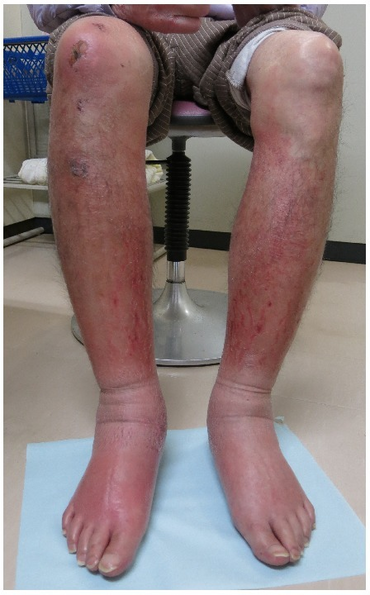Xerotic eczema
| Xerotic eczema | |
|---|---|
| Other names: Eczema craquelé, Pruritus hiemalis, Asteatotic eczema, Winter itch,[1]: 81 Desiccation dermatitis, and Winter eczema[2]) | |
 | |
| Asteatotic eczema (with lower limb edema ) | |
| Specialty | Dermatology |
Xerotic eczema is a form of eczema that is characterized by changes that occur when skin becomes abnormally dry, red, itchy, and cracked.[3] It tends to occur more often during the winter and in dry conditions. The lower legs tend to be especially affected, although it is also known to appear in the underarm area.[citation needed]
Xerotic eczema is common in elderly people, though it is not uncommon for people in their 20s. It can appear in red, bumpy, pimple-like irritations. Shaving can cause it to become inflamed.[citation needed]
The first method that should be taken when treating xerotic eczema is attempting to re-hydrate the dry skin using a humidifier and bathing/showering less frequently. Mild and moisturizing soaps should be used to prevent further irritation.[4] Scratching the affected area should be avoided. Applying moisturizing lotion or anti-itch ointment frequently should help in reducing dryness.
If the re-hydration process does not alleviate the symptoms, moisturizers such as Lac-Hydrin 5% or 12% moisturizer containing urea can be used; furthermore, if the skin becomes inflamed or cracked, mid- to high-potency corticosteroids can be used.[5]
A study published in 2005 found positive results from soaking the affected area in water for twenty minutes and then applying mid- to high-strength corticosteroid ointment.[6]
See also
References
- ↑ James, William; Berger, Timothy; Elston, Dirk (2005). Andrews' Diseases of the Skin: Clinical Dermatology. (10th ed.). Saunders. ISBN 0-7216-2921-0.
- ↑ Rapini, Ronald P.; Bolognia, Jean L.; Jorizzo, Joseph L. (2007). Dermatology: 2-Volume Set. St. Louis: Mosby. ISBN 978-1-4160-2999-1.
- ↑ James, William D.; Elston, Dirk; Treat, James R.; Rosenbach, Misha A.; Neuhaus, Isaac (2020). "5. Eczema, atopic dermatitis, and non-infectious immunodeficiency disorders". Andrews' Diseases of the Skin: Clinical Dermatology (13th ed.). Edinburgh: Elsevier. p. 63-91. ISBN 978-0-323-54753-6. Archived from the original on 2023-12-28. Retrieved 2024-01-01.
- ↑ Mash, Marlene J.; Fedor, Maria; Bonnington, Lucy (2007-01-01). "Skin Problems". Primary Care Geriatrics: 612–623. doi:10.1016/B978-032303930-7.50061-4. ISBN 9780323039307. Archived from the original on 2022-04-20. Retrieved 2021-08-12.
- ↑ Mash, Marlene J.; Fedor, Maria; Bonnington, Lucy (2007-01-01). "Skin Problems". Primary Care Geriatrics: 612–623. doi:10.1016/B978-032303930-7.50061-4. ISBN 9780323039307. Archived from the original on 2022-04-20. Retrieved 2021-08-12.
- ↑ Gutman AB, Kligman AM, Sciacca J, James WD. Soak and smear: a standard technique revisited Archived 2012-02-13 at the Wayback Machine. Archives of Dermatology. 2005 Dec;141(12):1556-9.